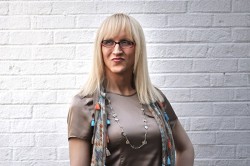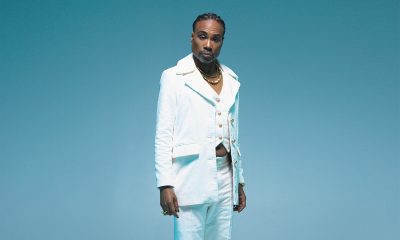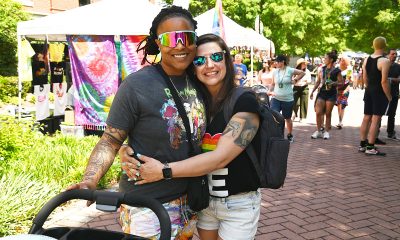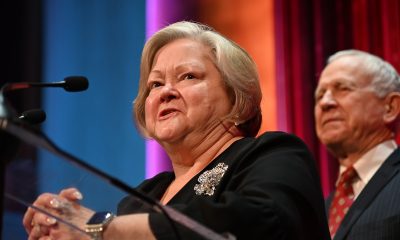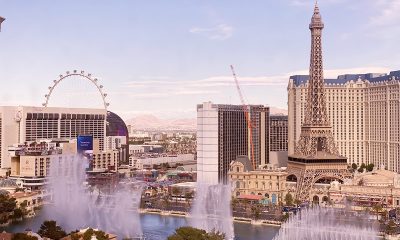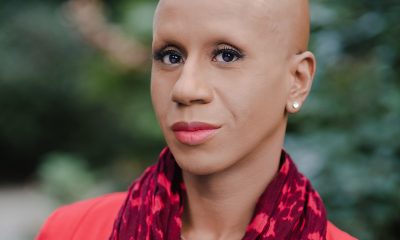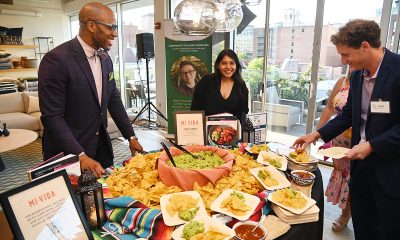Living
End of the movement?
Allies, athletes, bloggers, celebrities, musicians, lawmakers & locals discuss the future of LGBT advocacy
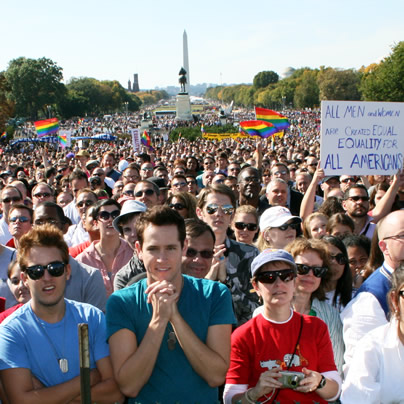
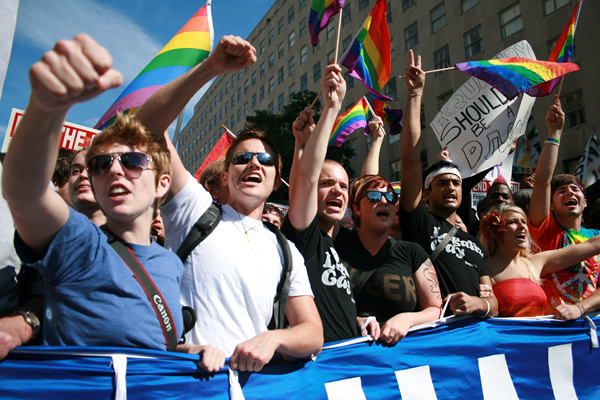
The National Equality March in Oct. 2009 (Washington Blade photo by Michael Key)
With the Supreme Court wrestling with some of our biggest issues and marriage rights expanding around the country, we asked several LGBT folks from all walks of life if the end of the movement could be near. Specifically, we asked:
“Have we reached a turning point in the LGBT rights movement and what does the end of the movement look like to you?”
Their answers will delight, surprise, provoke — and make you think.
(Compiled by Blade staff writers Michael K. Lavers, Chris Johnson, Lou Chibbaro Jr., Phil Reese and Joey DiGuglielmo)
SEE MORE ARTICLES IN THIS SERIES HERE
Heather Mizeur (Maryland State Delegate)
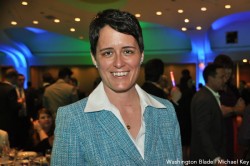
Maryland state Del. Heather Mizeur (D-Montgomery Co.) (Washington Blade file photo by Michael Key)
We have definitely reached a tipping point. With 12 states and counting, LGBT equality is on the march and there is no turning back. It was exciting for Maryland to play such a central role in being the first state below the Mason-Dixon line to pass marriage equality, and the first to affirm its support through the popular vote at the ballot box in 2012. In Takoma Park, when I ran for City Council a decade ago, my sexual orientation was not seen as anything interesting or special because the community had already grown to fully embrace all of its LGBT residents. Now, as I explore a run for governor of Maryland, I find that voters throughout the state are more impressed and interested in my ideas for the future than any concern over the fact that my wife would be their First Lady. We have come a long way.
I do not ever envision an “end of the movement” because as soon as we are done securing our own equality, we move on together as a community to address and tackle inequality every place it exists – poverty, racial bias and gender discrimination, to name a few. We will continue to work collaboratively, putting our community’s best talents forward, to affect positive social change for everyone.
Felipe Sousa-Rodriguez (GetEQUAL)
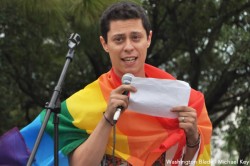
Felipe Sousa-Rodriguez (Washington Blade file photo by Michael Key)
It’s time to push for what we deserve.
Forty-four years ago, a group of drag queens and trans women of color — tired of the constant institutional violence perpetuated against our community — led the Stonewall riots. Riots turned into Pride and Pride continues to be our community’s opportunity to reflect on our progress, set forth our vision for equality and organize — because our lives depend on it.
Though we have made many gains, we are still severely unequal under United States law. We only have 15 percent of the rights of our straight counterparts. In my home state of Florida, I can be denied work, credit, housing, a marriage license and all manner of other rights essential to living the American dream. These issues become even more magnified when taking into account the multiple oppressions of race, immigration status, gender, etc. We have much ground to cover and waiting around is not an option.
Congress and the White House will continue to play politics with our lives unless we stand up now and push for what we truly deserve. Recently, Democratic leaders denied same-sex bi-national couples protections under immigration law; the president is sitting on an executive order that could protect 25 percent of the labor force in our nation against workplace discrimination. The incremental approach to equality is ineffective. We need a full federal equality bill. We owe it to those first mavericks who rose up and fought back against our oppression. It’s time for us to push our allies in Congress to stand up for our equality.
Gautam Raghavan (White House adviser)
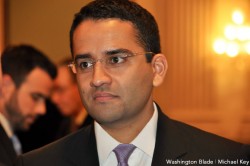
White House advisor Gautam Raghavan (Washington Blade file photo by Michael Key)
In his second inaugural address, President Obama spoke of our nation’s commitment to advancing equality for all people, a journey that “guided our forebears through Seneca Falls and Selma and Stonewall.” For the LGBT community and allies, those words were received with deep gratitude, applause and more than a few tears.
Since 2009, we have seen tremendous change unfold across the country: “Don’t Ask, Don’t Tell” repealed, hate crimes laws expanded to better protect the community, anti-bullying efforts increased, discrimination in federal housing prohibited and benefits for same-sex couples extended. As President Obama has said, this progress has not been led by lawmakers in Washington, but by ordinary citizens. It’s change driven by friends, families, colleagues and neighbors having important, heartfelt, sometimes tough conversations in neighborhoods, small towns and cities all across America.
As we reflect upon this rapid progress in the context of a decades-long movement toward equality, it can be easy to assume we’re near our journey’s end.
But if we take the president’s words to heart — “Seneca Falls, Selma, Stonewall” — we remember that movements for equality and social justice require continued commitment. Today, more than 160 years after the Seneca Falls Convention, women still don’t receive equal pay in the workplace. Nearly 50 years after Bloody Sunday, we continue to work toward full racial equality in education, housing and voting. And although the protesters at Stonewall may not have imagined marriage equality in their lifetime, their experience of violence, harassment and discrimination at work and at home still resonate in our community today.
This Pride month, we celebrate the progress we have made — through laws, policies and victories at the ballot box and in the courtroom — and we recommit ourselves to continuing our march toward a more perfect union.
I’m confident that our president will be with us every step of the way.
U.S. Rep. Mark Takano (D-Calif.)
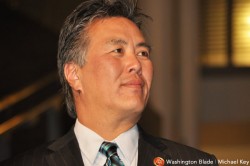
Rep. Mark Takano (D-Calif.) (Washington Blade file photo by Michael Key)
The LGBT rights movement is undoubtedly at a turning point as public opinion has moved in favor of LGBT rights and there are more LGBT federal elected officials than ever before.
But even more evident is that legislation coming out of Congress has become more reflective of true equality as laid out in the Constitution. With the Matthew Shepard Act and the repeal of “Don’t Ask, Don’t Tell,” hate-crimes protections were expanded and gay service members were allowed to serve openly in the military. Meanwhile, an increasing number of states have approved marriage equality and prohibited employment discrimination against the LGBT community through state initiatives and legislation.
For the first time in United States history, the president and a majority of United States senators support marriage equality and the Department of Justice is no longer defending the Defense of Marriage Act (DOMA) in court.
Martin Luther King Jr. once said, “The arc of the moral universe is long, but it bends toward justice.” At this moment in the LGBT rights movement, the arc is actually an acceleration curve. This is a turning point, but there is more to do before we reach the end of the arc, where full equality is recognized under the law and throughout our society.
Hassan Naveed (Gays and Lesbians Opposing Violence)
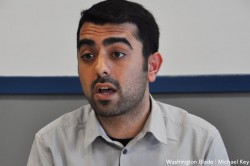
Hassan Naveed (Washington Blade file photo by Michael Key)
I think we’re at a crossroads. We’ve witnessed tremendous strides toward equality in the past few years. Public opinion on LGBT issues is progressing unquestionably in our community’s favor.
The recent political victories for marriage equality in several states represent major milestones. As we celebrate these successes and others to come, it’s important to recognize that only history will attest to the true turning points of the LGBT rights movement.
For now, advocates must stride toward equality mindful of all the issues faced by LGBT peoples. Job discrimination, unfair immigration policies, health inequities, homelessness and hate crimes are not new problems, but continue to haunt our community.
The movement’s path forward must address the needs of the most vulnerable and continually accommodate our immense diversity. We’ve reached a crossroads and the direction forward will be the true test of our morality as a people and our success as a movement. For me, the movement will end when we are truly free; to live our lives to the fullest without barriers based on gender expression and identity or sexuality.
Martin Garcia (Gertrude Stein Democratic Club)
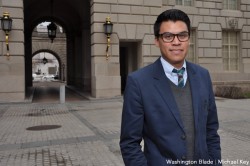
Martin Garcia (Washington Blade file photo by Michael Key)
As we watch the news and look at the national trends, it gets me very excited seeing all signs pointing to moving toward full equality. The number of successes in achieving marriage equality on the state level, the optimistic views on the upcoming Supreme Court decisions, national polls showing a rise in favor of LGBT rights show we definitely have the wind at our backs.
However, we still have a very long journey ahead of us on a number of issues affecting LGBT people and will need to continue fighting.
We need to continue the fight for HIV/AIDS research, education and funding to decrease the infection rate and raise awareness, that schools are safe for all LGBT students and staff, that we are secure being out at our jobs, that we are not discriminated against when finding housing, that we are supporting our youth to ensure they do not end up homeless or worse no longer with us, and fight to ensure that not only some of us are winning but that we are lifting everyone in our community up.
So as exciting and promising as these recent, and hopefully soon-to-be, victories are, we are not done and need to continue the fight for full equality.
Chad Griffin (president, Human Rights Campaign)
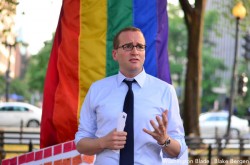
Human Rights Campaign President Chad Griffin (Washington Blade file photo by Blake Bergen)
This Pride month, the LGBT movement has so many reasons to be hopeful. From historic oral arguments at the Supreme Court, to victories for marriage equality in Delaware, Rhode Island and Minnesota, to the out-and-proud leadership of athletes like Jason Collins, Brittney Griner and Robbie Rogers, LGBT people and our families have never been so visible and so welcome in American life.
But, as a community, we can’t let progress distract us from the work left to do. We’ve got to make sure that every person in this country gets to see that progress, too.
The fact is that when transgender people still face truly shocking rates of harassment and violence, when a gay man can still be openly murdered on the streets of New York City for who he is, when LGBT youth are still roughly 10 times more likely to be homeless, our work is far from complete. We’re not even close to where we need to be.
So as we gather as a community to celebrate Pride, this movement needs a fire in its belly now more than ever. As long as any LGBT young person feels unwelcome in their community, their church or even around their own dinner table, we’ve got work to do.
Pride, after all, is a celebration with a message: equality everywhere for everyone. And that vision isn’t achieved until it reaches every single person in every corner of this vast country.
Amy Loudermilk (Mayor’s Office of GLBT Affairs)
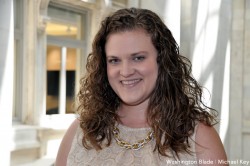
Amy Loudermilk (Washington Blade photo by Michael Key)
I think we’ve absolutely hit a turning point in the LGBT rights movement. With the recent explosion in the number of states approving marriage-equality measures, our president supporting full equality and the two Supreme Court cases set to be decided very soon, how could anyone deny the country’s mood is changing about this issue and that the momentum is very much in favor of equality? I also couldn’t be more proud that the District was one of the first jurisdictions with marriage equality.
That said, there are still lots of legal issues that need to be addressed and will take some time, with everything from retirement benefits to the availability of restraining orders to same-sex couples involved in domestic-violence situations. Ultimately, I don’t know what the end of the movement will look like because I don’t necessarily think it will end. For example, the women’s rights movement is still going on today because women still don’t make equal pay for equal work and in some states don’t have full control over their own bodies. Similarly, the civil rights movement continues today because we are still trying to fix policies that unfairly target people of color and still overcoming the lingering effects of centuries of institutionalized racism.
Prejudice in general will always exist, so I think this movement and others will continue for a very long time. And it should continue because the world’s learned a lesson about what happens when you are silent about discrimination.
Scott Wooledge (activist)

Scott Wooledge (Photo courtesy of Wooledge)
There is no end.
The work is never done, nearly 50 years after the Voting Rights Act was passed, the battle to stamp out institutionalized racism that denies people of color their votes is still front and center; in the Supreme Court, in lower courts and legislatures. And 93 years after the 19th Amendment was ratified, women still hold only 18.3 percent of the 535 seats in the 113th U.S. Congress (and zero presidents thus far).
Though we have nearly all one could hope for in here in New York, we have yet to pass transgender protections. And all LGBT communities will forever be tasked with fighting for their seats at the table and ensuring government serves the unique and specific needs of our community. In New York, we have ongoing battles to ensure our leaders don’t balance tightening state and local budgets by slashing funding for our most vulnerable (and lobbyist-free). Constituencies like indigent with HIV and homeless youth depend on our voices. Social safety net programs, like unemployment, are particularly important to a community that faces discrimination in employment and housing.
But of course I have seen the LGBT community evolve dramatically in my lifetime.
We’ve long been bound by our shared desire not to be outcasts from stalwart mainstream institutions, like the military, the Boy Scouts and marriage. And we’re winning. The question becomes, does the LGBT community have core values that bind us other than just being shunned by straight people? Fighting to expand options will result in more people exercising them. Witness the malaise of the gayborhood as LGBT people no longer feel awkward and unwelcome in more traditionally straight areas.
Ironically, there now seems to be a sense among some that actually choosing to join those institutions is an expression of betrayal to the larger community; “assimilate” and “heteronormatives” are said with derision.
I tip my hat as enthusiastically to the gender-transgressive anarchist as I do the Marine and the suburban soccer mom. I am confident this is the beautiful mosaic that makes our community, and America, beautiful.
Zack Ford (ThinkProgress.org)
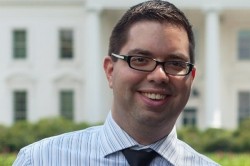
Zack Ford (Photo courtesy of Ford)
The LGBT movement will not end during any of our lifetimes. In the next few decades, we may complete many of our legislative goals, such as marriage equality, nondiscrimination protections, bullying oversight and others, but the work will continue. These legal victories will shift the priorities of our movement to focus more on education, advocacy and support, but opponents of LGBT equality will no doubt continue to challenge our community’s full inclusion in society.
People of color still endure unfair treatment under “Stop and Frisk” and voter suppression laws; women still don’t have equitable salaries or access to health care; and people with disabilities still must fight for accessibility as they challenge basic prejudices. History proves that a change in the laws does not automatically end all oppression.
As LGBT people, we will always be a minority with identities that are, by nature, invisible. We will always have to come out; we will always have to help other people understand how our lives are different. But my perspective is not a pessimistic one. Our momentum is strong and the work is rewarding. For many people, advocacy — and even pride — may become a much smaller priority as it becomes easier for them to integrate, an acknowledgment of the movement’s success. But equality is not a box to be simply checked off; it must be maintained like a garden. Until being queer is as uncontroversial as being left-handed, there will always be a place for the movement in some form.
Michael Crawford (Freedom to Marry)
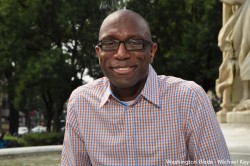
Michael Crawford (Washington Blade file photo by Michael Key)
I’m not sure that there will be an end to the LGBT movement. We tend to think about the “LGBT movement” as being about established groups and activists fighting to pass legislation and that the goals of the movement as being primarily legislative. I think we limit our possibilities for achieving true equality if we limit ourselves to thinking solely about passing legislation.
Instead, we should think about our legislative goals around issues like nondiscrimination, marriage and bullying as first steps toward transforming and reshaping the dominant culture in ways that will result in freedom for everyone.
I also think we need to take seriously the responsibility we have to help improve the lives of LGBT people across the globe. And we need to recognize that we have a lot to learn from activists in other countries who are advancing more rapidly than we are.
Just as there’s a continued need for black advocacy groups, I think there will be a continued need for activists who push us toward greater freedom. What those activists and advocacy groups will look like will change as we change the culture, but there will be a continued need for them as long as there are LGBT people.
Emily Saliers (Indigo Girls)
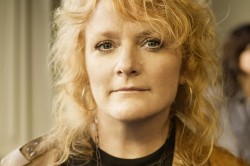
Emily Saliers (Photo courtesy of Russell Carter Artist Management)
It’s a very good and complicated question. What’s good for some of us is good for all of us. Gay marriage — even if the whole population of queer folks decided not to get married, that’s not the point — is an important right to have. And I know exactly what the other issues are. We’ve got high teen suicide rates and homelessness. You can start talking about the church and forget about it. I’ve seen the personal pain, the issues of health, gay couples lacking protection. I know all these realities. But gay marriage has become the linchpin because for society, it’s such a huge shift. The idea that gay marriage could be legislated and protected is one of those massive, massive things that is good for all of us.
The evolution of social issues is painfully slow. Just ask an African American if they’re still suffering the effects of slavery. Of course they are. You see it all the time in the stereotyping of black people in culture. My partner is Canadian, so the day after our show I’m going to be on the Hill with my partner and my baby to say, “This is what a family looks like.” If DOMA isn’t repealed, we’re moving to Canada. We’ll have no other choice. But having the right to get married is a massive sociological shift and for gay marriage to be legislated, I don’t have anything negative to say. It’s about the recognition of equal rights.
Bil Browning (Bilerico Project)

Bil Browning (Photo courtesy of Browning)
The LGBT movement will never die. Instead it will slowly amorphize as the dollars dry up and interest wanes. As we’ve already seen after the repeal of DADT, success means downsizing is inevitable.
Once basic protections for employment, public accommodations and housing have been passed and same-sex marriages are recognized at a federal level, LGBT people will become complacent. The fight for LGBT rights will move to the states as each one separately fights for marriage equality.
Groups that work on other issues will consolidate with larger organizations as funding shrinks and our community is mainstreamed. As with African-American civil rights organizations currently, a couple of groups will dominate the landscape with smaller orgs buzzing around the periphery.
I see Freedom To Marry flourishing by investing in these local battles and wouldn’t be surprised if it became deeply involved internationally. It would likely require a name change, but it could easily swallow other groups that work on family issues like Immigration Equality, Family Equality Council and PFLAG. Established and respected organizations like GLAAD, Trevor Project, Outserve/SLDN, and the Task Force all do valuable work, but in the end could comfortably be incorporated into a more broadly invested HRC, which already has more funding and name recognition.
Sadly, many of these third-tier groups are already struggling financially and will always remain in the “also ran” category because they’re not as well known. The non-profit industry at its core is a business like any other. As in the corporate world, the LGBT movement will consolidate for ease of operation, a larger customer base and maximum profits.
Carl Schmid (The AIDS Institute)
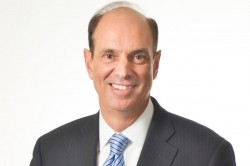
Carl Schmid (Photo courtesy of Schmid)
The LGBT rights movement has progressed slowly over several decades, spurred on by distinct events, including the AIDS crisis in the early ‘80s that led many gay men to publicly “act up” and all too often see either themselves or their friends and loved ones die. Sadly, thousands did die, though much has changed since those early days, in some ways things are still the same. Although we know how HIV can be prevented and treated, and research continues toward finding a vaccine and cure, the end is not in sight.
While people are living longer due to the advent of antiretroviral medications, gay men still shoulder two-thirds of all new HIV infections, about 33,000 new cases each year. A recent study found that one in five gay men in 21 cities have HIV, half of whom do not even know it. Unfortunately, the number of new cases is rising for those under age 25, particularly among young black gay men.
But how many of your friends talk about HIV or their own HIV? While the stigma and discrimination surrounding LGBT people has decreased, the same cannot be said for people with HIV.
It is my hope the progress that has been made in the LGBT movement can impact HIV among gay men. With a more accepting and affirming society and legalization of same-sex marriage, perhaps some factors that lead to HIV transmission will be reduced.
While much progress has been made, I do not see an end of the movement as it relates to HIV among gay men until parents and schools not only teach sexual education that encompasses homosexuality but normalizes being gay and gay relationships. Yes, great strides have been made, but so much more must occur.
Dave Kolesar (WGAY)
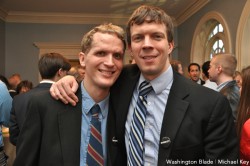
Dave Kolesar, left, and his partner, Patrick Wojahn, in Annapolis for the Maryland marriage bill signing. (Washington Blade file photo by Michael Key)
I think we have reached a turning point in the LGBT rights movement. When my partner Patrick Wojahn and I first became involved in the Maryland marriage lawsuit in 2004, many of our friends thought we were crazy. Support for same-sex marriage was polling in the 30s and Massachusetts was looking like an outlier, having just granted equal marriage rights to same-sex couples.
Almost 10 years later, marriage equality exists in about a dozen states and the victories for LGBT issues in four states at the ballot box last year showed not only that the sky didn’t fall, but that momentum has decisively swung in favor of the LGBT movement.
I don’t know what the end of the movement would look like, as I think it still has a long way to go. The marriage question may be largely settled within a decade, but there are many other important issues that need to be addressed — employment discrimination and transgender rights are probably the next big fights. And while we certainly have been successful over the past few years, recent attacks in New York City suggest that we have to be on guard against a violent counter-reaction to the success of our movement. Unfortunately it seems that in society, wherever there is a minority, there is discrimination and the hope is that one day there will be enough moral progress such that we all realize that all of us have much more in common than we do differences.
Chris Kluwe (Oakland Raiders, ally)
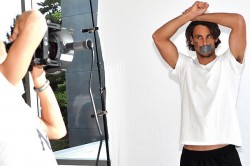
Chris Kluwe (Photo by Joe Bielawa)
This is a question that I don’t think has an answer anyone wants to hear.
I’ve always tried to be honest and examine the world through the lens of what is, not what I would like it to be and yes, I think we’ve reached a turning point in the LGBT rights movement in the United States, but I don’t think we’re anywhere close to the end of the movement.
The struggle for LGBT rights is the same struggle for women’s rights, the same struggle for religious rights and the same struggle for civil rights humanity has waged for the entirety of its existence, and it’s happening all over the globe — the struggle to live your own life, free of oppression, without oppressing others.
This is the battle that every generation in every nation has to fight, and will continue fighting, until the day comes when we’re all finally empathic enough to understand what effect our actions can have on other people.
Yet even though we may not see the end of that struggle in our lifetime, it is a struggle worth fighting for, because every step we take, every inch we gain in treating others with respect and dignity, is another building block our children can use to make their own progress, to build their own better world.
The end of the movement may never come, but that doesn’t mean we should stop working toward it.
Ruby Corado (transgender activist)
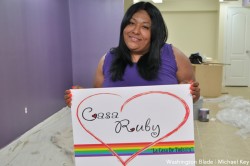
Ruby Corado (Washington Blade file photo by Michael Key)
No, we haven’t reached a turning point in the LGBT rights movement yet. We have helped others reach that point and helped changed the minds of many people.
These days we have many politicians who are legislating for us not just against us. We have a mainstream media that covers more positive stories about our lives than ever before. We have faith communities that are embracing our pursuit of dignity. We have America understanding LGBTs as human beings not just as a sexual orientation, gender identity and/or expression. But our LGBT movement has not reached a turning point among those who are LGBT. We are a movement divided by race, gender, social and economic status, ideals, geographical areas. We are a movement that does not support the young, the elder, the disadvantaged, the marginalized, the gender non-conforming and/or transgender.
I see the end of our movement looking like the rainbow that we love and embrace so much, a movement where every color (every gay, lesbian, bisexual and transgender) complements, sticks together and supports one another no matter what challenges or struggles we face through our individual storms.
At the end, we, just like the rainbow, shine together happily.
Hector Fonseca (DJ)

Hector Fonseca (Photo courtesy of Management 360)
I think there have been a number of turning points recently. The end of “Don’t Ask, Don’t Tell.” Legalization of marriage in several states and countries. An active pro athlete coming out. Those are all great moments and turning points in the LGBT community we should celebrate.
I personally think Lady Gaga should get more credit than she is getting. In my eyes, she got the ball really rolling a few years ago. Gaga made it cool again for other pop artists and celebrities like her to care about gay rights again. Kudos to her for restarting the movement.
The end of the movement to me would be a few things including openly gay pro athletes, an openly gay president and the same full equal rights that heterosexuals globally enjoy. I don’t think any of this will happen until we as a community really stick together to support LGBT causes and those who respect our community, only.
We also need to stop glorifying bullying and putting hateful people on pedestals (e.g. “She’s such a bitch, I love her.”). When we stop doing this, we will get much further much quicker. We have come a long way but there is much more work to be done.
Holly Twyford (actress)

Holly Twyford (Photo by Scott Suchman, courtesy Studio Theatre)
There’s a big difference between a tipping point and an end point. The biggest challenge the gay community has always had is we’ve never had any clear agenda other than equality. Is marriage equality the golden egg? Maybe legally so, but what does it really mean for us to reach an end point because you have to address the continued bigotry that still exists.
Of course it’s incredibly important that marriage is in front of the Supreme Court but now we need Joe Schmoe American to say, “OK, I buy into that too” or “I just met two lesbians with a child and they seemed like great parents.” So I guess my answer is yes and no. Yes, it’s a huge, exciting paradigm shift, but is it the end of the movement? No.
I think marriage is being very much held up as the brass ring because it’s a clear, visible, everyday symbol of what has been denied to us. You know, we can talk about workplace discrimination, but it’s harder to see, whereas me and my partner getting up in front of a church and someone saying, “By the power vested in me … ” that’s something very visible and you can say wife, not partner. It’s like, “Oh, OK, so you’re not married?” “Well no, but we’ve been together 20 fucking years — we’ve been together longer than you and your husband.” It’s just so great not to have to explain all that. It’s a huge symbol.
Melissa Etheridge (singer)

Melissa Etheridge (Photo by James Minchin III)
I don’t think there will ever be an end of the movement.
I think the time we can kinda go, “Whew,” is when we know that we can walk in any city and beside any stranger and understand that what makes me different from them is not something that’s fearful to them. I’ve seen such fear among people of what is not understood and what we’ve done over the last 20 years is to slowly, day by day, say, “We are people. We’re your neighbors, your children, your friends, we work with you, we are part of every community. We’re everywhere in the whole world, we are a piece of every civilization and what we bring to the table only makes us better as a nation and as a world.”
To understand that diversity and not be fearful of it is really the ultimate step. Gay marriage is important because it’s actually something you can legislate. You can’t go before the Supreme Court and say, “They’ve gotta stop hating me,” you just can’t pass that kind of a law. But you can find a way to legislate certain rights. I’m not saying we should all get married. Anybody can see I personally haven’t really been very good at it so far. Yet to have the right to do so is vitally important.
When I was a teen, for instance, there wasn’t even really any sense of gay marriage as a concept. We didn’t even really have the words for it or if there was, it was all bad. And yet here it is a generation later in front of the Supreme Court. As every new generation comes along, the fear dilutes.
Mame Dennis/Carl Rizzi (Academy of Washington)
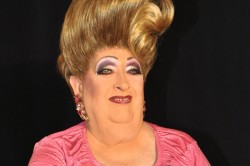
Mame Dennis (Washington Blade file photo by Michael Key)
We’ve had gay weddings in the Academy for years. They weren’t legal of course, but we had them. I guess if the Supreme Court makes them legal and everything, that’s fine, but I don’t really think it’s going to solve anything.
I have to be honest, I shudder a bit when I think of all these people who will probably rush out and get married. I do think the gay girls take it a little more seriously than the men, but I think with the guys, they trick with someone and think they’re in love and I can easily see them running off and getting married and then what, eight weeks later or something, realize, well no, I’m not really in love. I’m concerned about the after effects. I think there’s going to be a huge spate of gay divorces if this goes through and that will look really bad for the community. That might give us an even worse name. You know how some of these queens are.
I think we have to spend more time earning respect and acceptance in the workplace and in the community and society in general. That’s the most important thing we have to concentrate on.
People seem so obsessed with this marriage stuff and there are so many things out there that are more important. I’m also concerned with how it will turn out when these queens run out and jump into marriage and realize later they can’t get out of it so easily. That’s not to say everyone will get divorced, of course, but some will and we’ve been so used to just shacking up for so many years and being able to leave whenever we want. It won’t always be so easy to do that. The gay girls, at least the ones I know and have been associated with, seem to stay in their relationships forever. They seem to want to make more of a commitment.
David Lett/Lena Lett (priest/drag queen)

David Lett (Washington Blade file photo by Michael Key)
For me, marriage is not the brass ring. It certainly is a milestone and it does get us a little bit closer to overall equality, but is this the end of the movement? Unfortunately I don’t think that will ever happen. I don’t think blacks could ever foresee a day when the NAACP could go away and everything would be fine from then on. Even struggles that we think of as being from a totally different era, like the Irish fully finding their place in society, as long as there’s sickness and sadness in the world, there will be discrimination and as long as you have people bound by ignorance and bound by fear, then you will have the haves and the have nots and there has to be a group for the have nots.
I don’t think it’s realistic at all given human nature, for any of the groups to just say, “OK, we’re done — let’s pack up and go home.” The people who are there to make sure these things are fully accepted over the long haul, those people will always have a job.
I don’t really see marriage — and this is from somebody who performs them — as that big a deal. I can see it symbolically and for long-term relational issues like money and securities and inheritance and that sort of thing, but it’s not really as big as some of the other issues.
If you think about it, most professionals who are involved in weddings — clergy, dress designers, event coordinators, cake decorators, organists — you’re dealing with a lot of people who happen to be gay themselves and so to be denied that themselves is a real slap in the face. It’s the same thing as it was for black people — “Oh, it’s OK for me to work in the dining room but it’s not OK to sit in the dining room?” That shit doesn’t work anymore. We’ve progressed too far and worked for too long to get where we are.
And all this will outlast the conservative movement. They’ve basically said, “Marriage, oh my God, you can’t touch that, we’ll have a constitutional amendment,” but once you start messing with the Constitution, that’s a really big deal. That’s not just a little state picking on you, that’s the whole government saying, “No, you’re an invalid creature.” But no, you will not mess with the Constitution to say that I am less than. The movement has really been the perfect example of Newton’s Law — for every action, there is an equal and opposite reaction. They came out with this stuff and we came back full force. I don’t see that ending anytime soon.
Allyson Robinson (OutServe-SLDN)
At OutServe-SLDN, we’ve seen the future of the LGBT civil rights movement. We live in that future every day.
As the morning of September 20, 2011 dawned on American military installations around the world, gay and lesbian service members awoke to a new reality: their service in defense of this country would no longer be contingent on a willingness to lie about who they were. Ending “Don’t Ask, Don’t Tell” was an historic accomplishment, decades in the making, and with it, our two predecessor organizations — Servicemembers Legal Defense Network and OutServe — achieved the goal around which they had been rallying support for years.
But when the celebrations ended and we took stock of the new military we’d helped create, we realized our work wasn’t over. It was just getting started. Gay and lesbian troops could now be “out,” but they were anything but equal.
Passing good laws and enacting good policies is hard work. Changing culture is much harder. That’s the mission we’ve claimed for ourselves at OutServe-SLDN — building a culture of inclusion and respect for LGBT people in our military — even as we continue the fight to end the discriminatory policies that remain. And that’s the work that awaits nearly every LGBT advocacy organization in America on the other side of that new world we’re hoping to create by pulling down DOMA and enacting nondiscrimination policies. It will be the work of generations, but take it from us: if you haven’t started yet, you’re already behind the power curve.
Real Estate
What property should I purchase if I’m not sure how long I’ll be in D.C.?
Row homes, English basements and more options abound
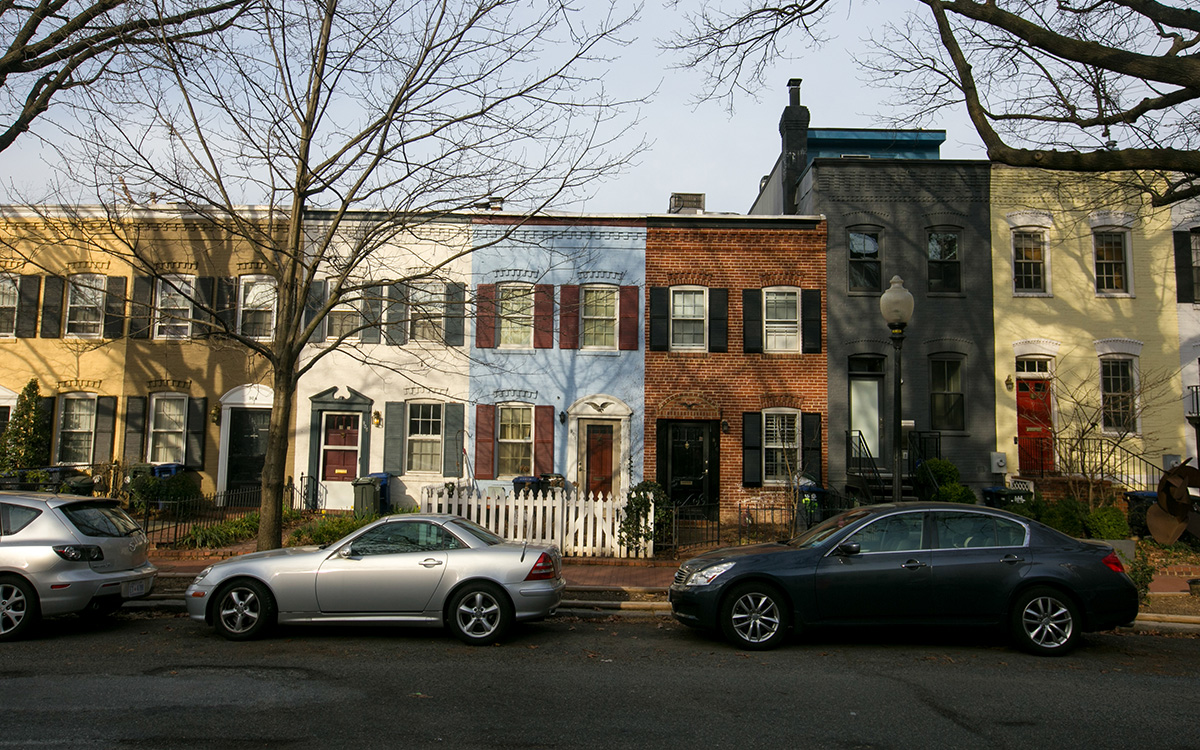
Great question! If you are looking at real estate as an investment – two great property types to look at would be a smaller row home and also a row home that has an English basement. Some property types that you might want to stay away from would be a condo or a co-op unit. Let’s take a look at why these properties would be good and bad:
Smaller Row Home
Row homes are a great investment for many reasons. You can often find smaller two-bedroom row homes in the same price point as those of a two-bedroom condo, which might be seen as a “condo alternative” and afford you much more freedom. There are no condo associations or home owner associations that you must belong to so this keeps your monthly carrying costs on the lower end and you are allowed to make more independent decisions. For example, if you wanted to paint the house purple – in most cases you would be allowed to. If you wanted to change the color of the front door or put shutters on the windows – you would be allowed to. This is usually not the case with condo or co-ops.
When it comes to the rental market – similarly renters like the independence of privacy in a home and not being among many other people. The luxury of perhaps direct off-street parking, outdoor space or even just more space at the same rental amount that a two bedroom condo rent would be – this is more appealing for a renter and would likely rent faster than that of a condo or co-op. For this model – you would obviously need to move out before you could take advantage of the investment of this type of real estate.
A row home with an English basement
With this type of real estate you can immediately begin receiving income after your purchase. You can occupy the upstairs of the row home, which is usually the larger portion of the home, or you could even occupy the basement, which is usually the 1-2 bedroom smaller portion of the home and receive rental income for the other half of the home. This can be in the way of a yearly traditional tenant or in the manner of short-term rentals (check with the most recent STR policies within the District). With this model, you stand to make even more of a return on your investment upon your move out of the home as you can rent the entire home or you can rent the top unit and basement unit independently to gross a larger amount of income. It is important to note that it is never advised to purchase a row home unless you can fully afford it WITHOUT the idea of accepting additional rental income to offset the mortgage cost.
These two options listed above are the most typical found within the District because they are fee simple, standalone pieces of real estate and are not within a condo association, HOA, or a co-op with governing documents that tell you what you can and cannot do which makes row homes an attractive type of real estate for a long-term hold.
When looking at types of properties that you might want to stay away from – condos and co-ops come to mind and I say this with a caveat. You can surely purchase these types of real estate but must first understand the in’s and out’s of their governing documents. Condos are bound by the governing condominium documents which will tell you for how long your lease must be, a minimum of lease days, you can only rent after you have lived in the residence for a number of years, likely will stipulate no transient housing – which means no short term rentals. It could also quite possibly say that you can only rent for a specific amount of time and lastly it will also stipulate that only a specific amount of people can rent at one time in order to stay below the regulated lending requirements set forth by Fannie and Freddie Mac. Similarly, Co-ops are even more strict – they can tell you that you are just not able to rent at all or if you can you can only do so for a specific number of years and then you are required to sell or return back to the unit as your primary residence.
As you can see, when it comes to condos and co-ops there are more specific and stringent bylaws that owners must agree to and follow that limit or even outlaw your ability to rent your piece of real estate. When you purchase a row home – there are no regulations on what you can and cannot do regarding rentals (outside of the short-term regulations within the District).
When looking for a piece of real estate in the District it is important to think through how long you could possibly wish to hold onto this property and what the future holds. If you think this is a long-term hold then you might consider a row home option – again, you can find a smaller two-bedroom row home that amounts to that price similar to a two-bedroom condo and would afford you a more flexible lifestyle. It’s important to work with a real estate agent to ensure that they guide you in this process and help answer any questions you might have. It’s also always advised to speak directly to a short-term rental specialist should you wish to go down that route as they will truly understand the in’s and out’s of that marketplace.
All in all, there are specific property types that work for everyone and within the District we have a plethora of options for everyone.
Justin Noble is a Realtor with Sotheby’s International Realty licensed in D.C., Maryland, and Delaware for your DMV and Delaware beach needs. Specializing in first-time homebuyers, development and new construction as well as estate sales, Justin provides white glove service at every price point. Reach him at 202-503-4243, [email protected] or BurnsandNoble.com.
Business
Heather Lawver’s journey to growth, inclusion with Ceemo.ai at StartOut’s Growth Lab
‘A program that embraces unique challenges LGBTQ+ founders have’
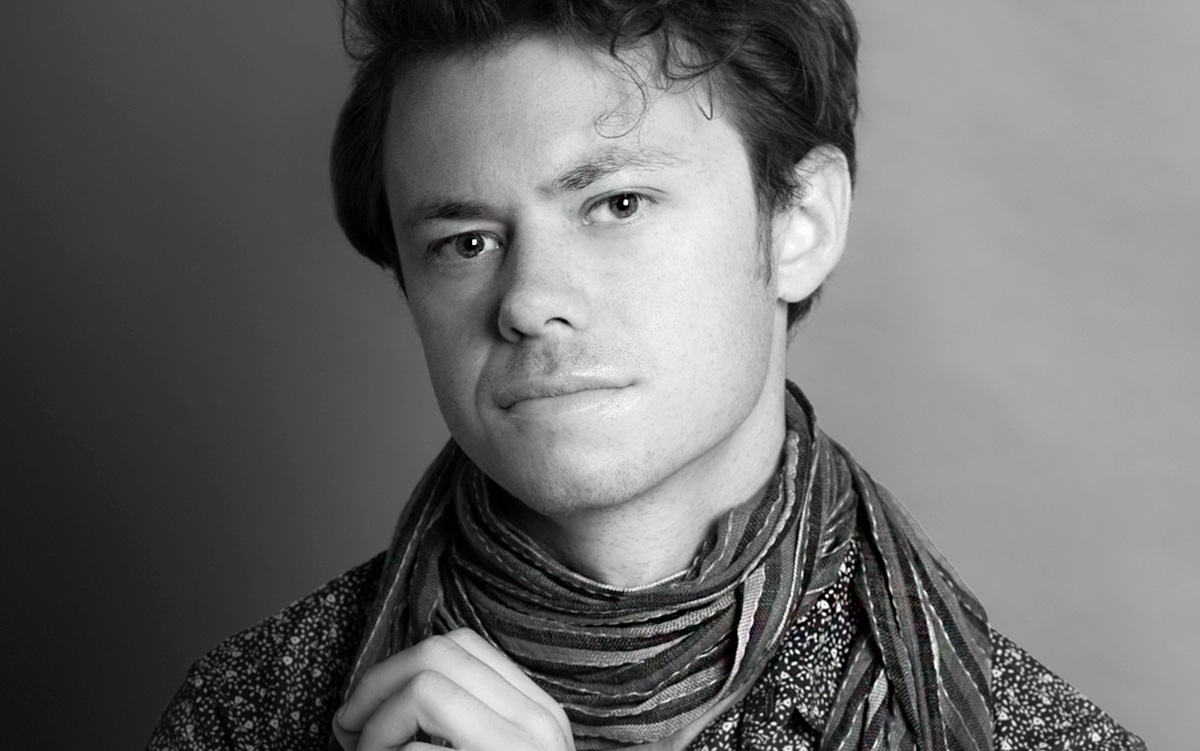
In the bustling world of startups, where innovation and diversity intertwine to forge new pathways, Heather Lawver, founder and CEO of D.C.-based Ceemo.ai stands out not just as a visionary entrepreneur but as a beacon of inclusivity and determination. Her journey to build Ceemo.ai, an advertising and branding platform dedicated to revolutionizing how startups conceive and market their brands, has reached a pivotal milestone with its selection into StartOut’s esteemed Growth Lab Accelerator, sponsored by J.P. Morgan.
With less than one percent of startup funding being allocated toward LGBTQ+ founders in 2023, according to a recent StartOut study, this five-month program is critical in providing resources and education to help LGBTQ+ entrepreneurs grow and compete.
Ceemo.ai joins eight other companies nationwide for this exclusive five-month training program.
A commitment to inclusion
Lawver founded Ceemo.ai in 2021 as a way to help entrepreneurs build better brands and seamlessly apply them to the marketing and pitch materials they need to launch the company of their dreams. The company’s simple five-step brand quiz helps founders think strategically about how they want to be perceived by their customers to then generate a full brand book with wordmark logo, color scheme, and font suite. Ceemo then applies that new brand book to a full suite of marketing and pitch materials, giving founders a roadmap to making sales and securing investment.
Her application to the Growth Lab Accelerator cohort was driven by more than the desire for business growth; it was fueled by her longstanding volunteer work with StartOut and a profound commitment to fostering an environment where LGBTQ+ founders are not only included but celebrated.
The selection of Ceemo.ai for StartOut’s Growth Lab, an accelerator known for its top-quality mentoring, education, and networking opportunities tailored for LGBTQ+ founders, marks a pivotal chapter in Lawver’s mission to help cultivate a more inclusive entrepreneurial landscape.
“Being in an accelerator where I’m not the only queer person in the room is not just empowering; it’s transformative,” she shares. “It means so much to be selected for a program that embraces the unique challenges LGBTQ+ founders have, and these issues are not just acknowledged but are central to the narrative of success and innovation.”
“The founders in our 2024 Cohort are problem solvers, developing unique products and solutions across a range of industries, from technology and software to food and beverage,” said David Barbee, Head of LGBTQ+ Initiatives, J.P. Morgan Commercial Banking. “As they continue to scale, these companies will need access to resources like capital and banking solutions, investors and business advisors. We are proud to provide mentorship and access to our firm-wide capabilities to help them reach the next level.”
“This platform is not just an accelerator; it’s a community where the unique challenges and triumphs of LGBTQ+ founders are acknowledged, celebrated, and used as a springboard for groundbreaking business success,” said Lawver.
Ambitious goals for bright future
Over the past decade, Lawver’s expertise in enhancing pitch decks and fundraising strategies has been instrumental in securing more than $170 million for minority entrepreneurs across various demographics, including women, BIPOC, LGBTQ+, disabled individuals, and seniors.
Her vision for her time in the five-month cohort is characterized by ambition and a keen focus on leveraging the program’s resources to scale Ceemo.ai’s impact. Her top goals include refining the platform’s Crunchbase algorithms to offer unparalleled market insights for startups, enhancing their organic sales funnels, and forging strategic partnerships with tech giants like Canva, Adobe, Google, Shopify, and Squarespace. These objectives are not just growth metrics but stepping stones towards revolutionizing how startups approach branding and marketing in a highly competitive digital landscape.
(Founded in 2009, StartOut, a national 501(c)(3) non-profit organization, is the largest national organization to support LGBTQ+ entrepreneurs with more than 28,000 members nationwide. Its mission is to accelerate the growth of the LGBTQ+ community to drive its economic empowerment, building a world where every LGBTQ+ entrepreneur has equal access to lead, succeed, and shape the workforce of the future.)
Real Estate
The rise of virtual home tours
Adapting to changing consumer preferences in spring real estate

In today’s dynamic real estate market, the spring season brings not only blooming flowers but also a surge of activity as buyers and sellers alike prepare to make their moves. However, in recent years, there’s been a notable shift in how consumers prefer to explore potential homes: the rise of virtual tours.
For the LGBTQ community, these virtual experiences offer more than just convenience; they provide accessibility, safety, and inclusivity in the home buying process.
Gone are the days of spending weekends driving from one open house to another – unless that’s your thing of course, only to find that the property doesn’t quite match expectations. With virtual tours, you can explore every corner of a home from the comfort of your own space – find something interesting? Schedule a showing with any LGBTQ Realtor at GayRealEstate.com.
This is particularly significant for LGBTQ individuals, who may face unique challenges or concerns when attending in-person showings. Whether it’s the ability to discreetly view properties without fear of discrimination or the convenience of touring homes located in LGBTQ-friendly neighborhoods across the country, virtual tours offer a sense of empowerment and control in the home buying process.
Moreover, virtual tours cater to the diverse needs of the LGBTQ community. For couples or families with busy schedules or those living in different cities or states, these digital walkthroughs provide a convenient way to view properties together without the need for extensive travel. Additionally, for individuals who may be exploring their gender identity or transitioning, virtual tours offer a low-pressure environment to explore potential living spaces without the added stress of in-person interactions.
At GayRealEstate.com, we understand the importance of adapting to changing consumer preferences and leveraging technology to better serve our community. That’s why our agents offer an extensive selection of virtual tours for LGBTQ individuals and allies alike – visit our website, choose an agent and within minutes you’ll have access to the Multiple Listing Service (MLS) via their website.
From cozy condominiums in bustling urban centers to sprawling estates in picturesque suburbs, virtual tours showcase a wide range of properties tailored to diverse tastes and lifestyles.
In addition to virtual tours, GayRealEstate.com provides comprehensive resources and support to guide LGBTQ buyers and sellers through every step of the real estate journey. Our network of LGBTQ-friendly agents is committed to providing personalized service, advocacy, and representation to ensure that all individuals feel respected, valued, and empowered throughout the process. Plus, we are happy to provide a free relocation kit to any city in the USA or Canada if you are a home buyer.
As we embrace the spring season and all the opportunities it brings in the real estate market, let’s also celebrate the power of virtual tours to revolutionize the way we find and experience our future homes. Whether you’re searching for your first apartment, forever home, or investment property, GayRealEstate.com is here to help you navigate the exciting world of real estate with confidence, pride, and inclusivity.
Jeff Hammerberg is founding CEO of Hammerberg & Associates, Inc. Reach him at [email protected].

